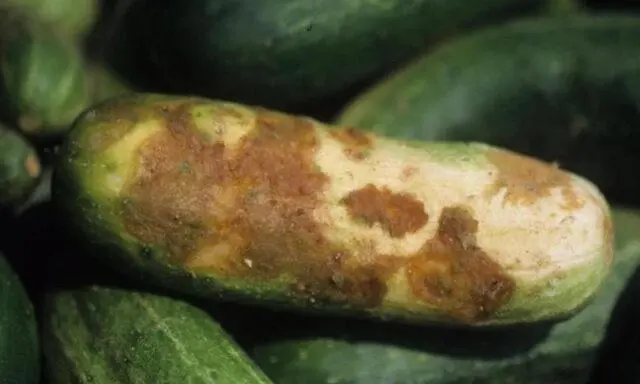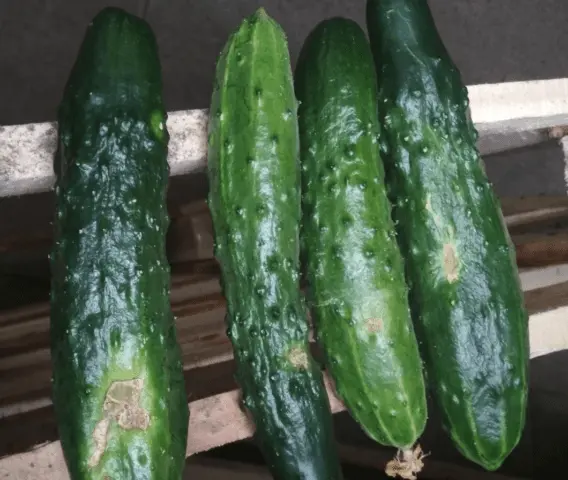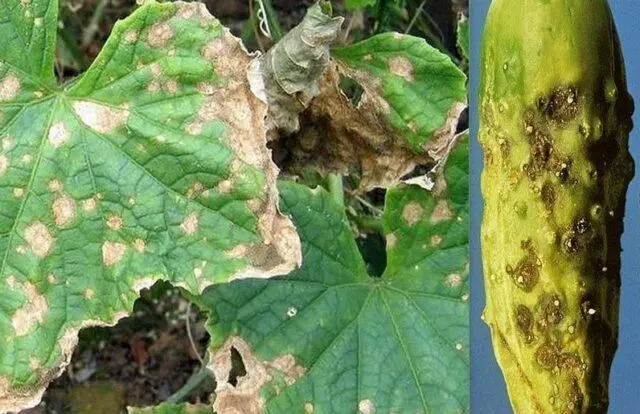Contents
Cucumber ascochitosis is a dangerous infectious disease caused by microfungi. Spread through infected seeds. For a long time it does not manifest itself, after which it affects all the ground parts of the plant – stems, leaves and fruits. The main preventive measure is pre-sowing seed dressing. For treatment, chemical and biological preparations, folk remedies are used.
Causes
Ascochitosis is a common infectious disease that is associated with the development of microfungi Ascochyta cucumis and Didymella bryoniae. It affects not only cucumbers, but also other species of the Cucurbitaceae family, including melon and watermelon. It is also called black mycospherella stem rot or cancer.
The main cause of cucumber ascochitosis is seed infection. In this case, the fungus does not multiply in the soil. It is noted that most often ascochitosis affects crops that are grown in a greenhouse. In the southern regions, the disease often affects cucumbers in the open field.
Fungi develop at normal or elevated temperatures ranging from 10 to 32 degrees. At the same time, they normally feel both at moderate and at high humidity (up to 100%). Therefore, excessive watering cannot be considered as a provoking factor (unlike other types of rot).
Signs of ascochitosis with a photo
Pathology does not make itself known for a long time – the seedlings of the seedlings look healthy, at this stage the signs of ascochitosis appear extremely rarely. The symptoms then spread throughout the plant, affecting stems, leaves, and fruits.
The stems
The defeat of cucumbers with ascochitosis can be determined by the condition of the stems. At the beginning of the season, rounded spots appear on them. At first they have a gray-green tint, watery in appearance. Then they acquire a brown color, dry out and become whitish.

As ascochitosis develops, spots on cucumbers grow, capturing the entire stem.
The surface cracks, a brownish or milky liquid flows out of the tissues. At the same time, the stems continue to develop, so the plant does not die off and even bears fruit. Numerous black dots are visible on the surface – pycnidia (fruiting bodies) of the fungus.
Leaves
If ascochitosis appears on the stems early enough, then the infection affects cucumber leaves during fruiting. First, large spots form along the edges of the leaf blades, reaching 5 cm in diameter. They have fuzzy edges, the color is pale green, yellowish.
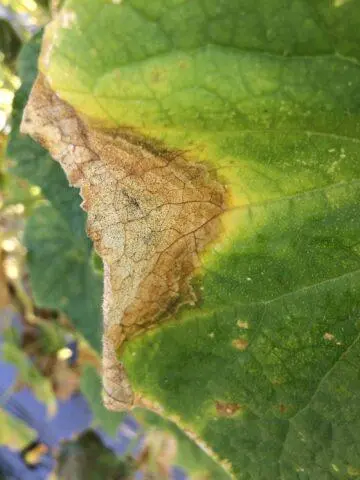
Cucumber leaves affected by ascochitosis can be identified by visual inspection.
Over time, the spots increase in size and can cover up to half of the surface of the leaf plate. The tissues acquire a brownish tint, then become light yellow. Pycnidia appear – black dots. If nothing is done, the leaves quickly wither and die.
Fruit
Signs of ascochitosis on fruits can be very diverse. In practice, there are three forms of the disease:
- The first is that the base of the fetus suffers first, and then its upper part. At the same time, the affected tissues dry out and become as if boiled, but at the same time retain their hardness. Pycnidia are noticeable on the surface, after which the entire cucumber turns black. In the future, it rots or, conversely, mummifies.

- The second – the surface of the greenery is covered with small sores (up to 5 mm in diameter), they contain pycnidia. The points are dry, there is no rot in them.

- Third – the middle part of the cucumber softens, then a rusty spot appears there. Gradually, ascochitosis spreads to the entire fetus, after which it dies.

Measures to combat cucumber ascochitosis
To combat ascochitosis, you can use folk remedies, chemical and biological preparations. As a rule, in the initial stages, you can treat with homemade solutions and infusions prepared on your own. But if the disease is advanced, biological agents will be needed. For prevention, as well as for dressing seeds, chemical fungicides are also used.
Chemicals
When ascochitosis appears, cucumbers are treated with various chemicals. Effective fungicides of systemic and contact action:
- “Rovral”;
- “Topaz”;
- “Topsin-M”;
- Fundazol.
The treatment is carried out using a sprayer, totally wetting the entire ground part of the plant. You can also shed the soil with a solution and pickle the seeds before planting. Treatment starts early in the morning or late in the evening.
Fungicide “Rovral” is used for watering the soil, dressing the seeds and processing the cucumbers themselves. The concentration of the working solution is 0,1%. To prepare it, measure 1 g of powder per 1 liter of water or 10 g per 10 liters (standard bucket).
The treatment of cucumbers with “Topaz” from ascochitosis is best done at the initial stage of infection. The solution is prepared in a ratio of 2 ml of fungicide per standard bucket. The second spraying is necessary 1-2 weeks after the first. During one season, it is enough to carry out 3-4 treatments.
Means “Topsin-M” gives good results when watering the soil under cucumbers. The solution should not be very concentrated – a dosage of 0,1% or 0,2%. The drug is fast-acting – the effect is noticeable a day after the processing of cucumbers. However, it should be borne in mind that it is quite toxic (second hazard class). Therefore, it is necessary to work with the solution with gloves and a mask.
“Fundazol” is another suitable fungicide against ascochitosis. Used for spraying cucumbers. The solution penetrates into the tissues of cucumbers through the surface of the leaves and the root system. To prepare the mixture, use 10 g of the drug per standard bucket of water or 1 g per 1 liter. The hazard class for humans is the second, that is, the use of individual protective equipment is required.
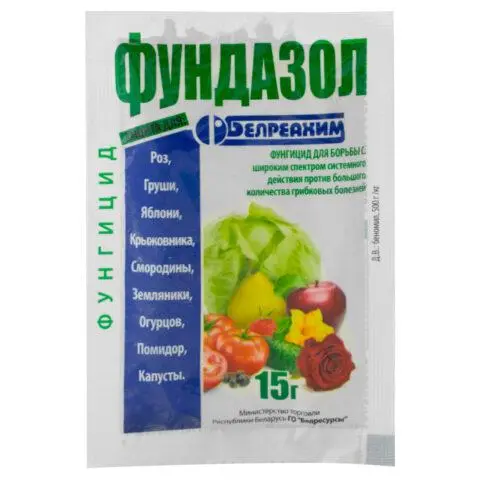
Powder fungicides are produced in bags of 10-15 g
Biological preparations
During fruiting, cucumbers should be treated with biological preparations. To combat ascochitosis, Vitaplan and Trichocin SP are most often used. These are effective remedies that completely destroy the fungi that cause cucumber pathology.
“Vitaplan” contains in its composition bacteria of the strain Bacillus subtilis in the amount of 1010 colony forming units (CFU) per 1 g. This is a beneficial microflora that destroys pathogenic fungi that cause ascochitosis. The drug is used for pre-sowing treatment and spraying cucumbers during the growth period. The concentration of the solution is 5 g per bucket of water.
“Trichocin SP” contains a special fungus Trichoderma harzianum in the amount of 1010 CFU. Designed for watering the soil and processing the green part of cucumbers during fruiting. It is recommended to water the soil a few days before planting seedlings, then again a week later. The standard dosage is 6 g per bucket of water.
Folk remedies
In the initial stages of ascochitosis, the ground part of cucumbers can be sprayed with homemade solutions prepared by yourself. To do this, use a mixture of the following components:
- laundry soap shavings – 20 g;
- milk of any fat content – 1 l;
- pharmaceutical alcohol iodine – 30 drops.
With the prepared solution, 2-3 treatments of cucumbers from ascochitosis are carried out with an interval of 10 days.
You can also use another composition:
- boiling water – 2 l;
- wood ash – 200 g;
- laundry soap shavings – 10 g.
First, the ashes are put in boiling water and infused for two days. Then soap is added, filtered and processed at intervals of one week.
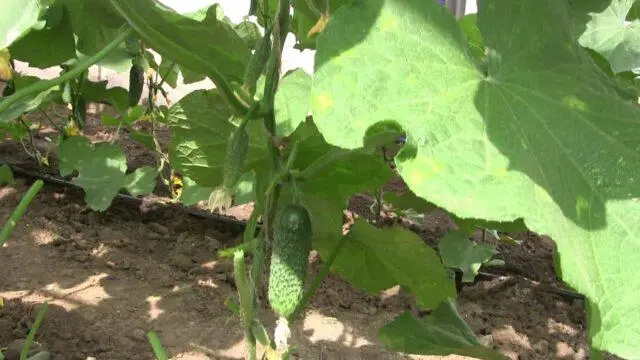
During fruiting, treatment is carried out with folk remedies or biological preparations.
This is a good way to prevent both ascochitosis and other infectious diseases.
preventive measures
It is quite possible to prevent the development of cucumber disease. To do this, experienced gardeners recommend adhering to the following rules:
- The main preventive measure is pre-sowing treatment of cucumber seeds. You can pickle them in a 2% potassium permanganate solution or in a fungicide solution (for example, Fitosporin, Tattu, Ordan and others).
- Choose hybrids and varieties of cucumbers for cultivation, which are distinguished by good resistance to various diseases, including ascochitosis.
- Carry out treatment with folk remedies or biological preparations during flowering and at the beginning of fruiting.
- Periodically inspect cucumbers. When the first signs of ascochitosis appear, remove the affected leaves, stems or fruits. In some cases, the plant needs to be dug up and burned.
- Observe the temperature regime in the greenhouse. Ventilate regularly, especially in hot weather.
- Treat the greenhouse with disinfectants in autumn or spring (all surfaces, doors, windows).
- After the end of the season, carefully remove foliage, tops of cucumbers from the greenhouse. They must be burned away from the site.
Conclusion
Cucumber ascochitosis is quite common, especially if you purchase seeds from little-known suppliers. It is quite possible to contain the development of infection and completely defeat it. To do this, you need to pickle the seeds and shed the soil with a fungicide before planting seedlings. It is also recommended to periodically inspect the planting of cucumbers and spray when the first signs appear.










